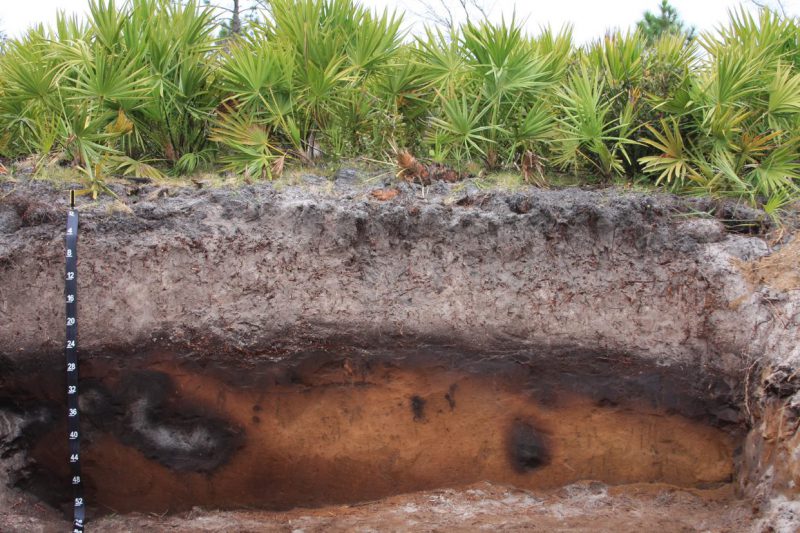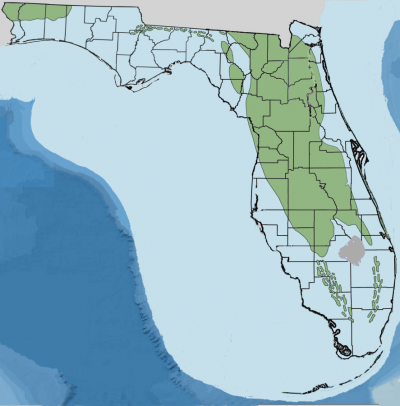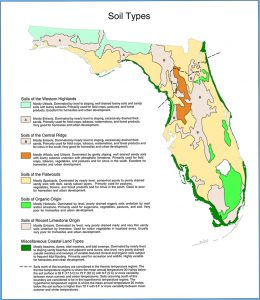
The Myakka soil series is the official state soil of Florida and is primarily found in the central and southern parts of the state. It includes white sand that has been leached of nutrients and a dark “spodic” layer where nutrients have accumulated. Photo by Rex Ellis, Landjudging.org.
Exploring the Ancient History of Florida’s Soils
Beneath the vibrant landscape of Florida lies a living canvas, a testimony to over 600 million years of geological evolution and ecological interactions. Soils, the very foundation of life, harbor secrets of our state’s past, shaping its diverse ecosystems and supporting its thriving agriculture. Delving into the rich tapestry of Florida’s soil history unveils a fascinating story of primeval waters, glacial eras, and the enduring dance between nature and human impact.
–
The Formation of the Florida Platform

The Florida Platform, depicted during the Miocene Era, 20.4 to 13.6 million years ago. Wikimedia Commons, image based on work by Edward Petuch, Ph.D., Florida Atlantic University, Dept. of Geosciences.
In the beginning, long before Florida became a sunny vacation destination, the region was submerged under ancient seas. The ceaseless tides of time deposited layers of marine sediments, creating the bedrock for the soils that would come to be. Millions of years of geological uplift, driven by tectonic forces, lifted the seabed from the depths. This gave birth to what we now know as the Florida Platform, which began developing in the Paleozoic Era over 252 million years ago, but further expanded in the Mesozoic Era, about 66 to 252 million years ago. The Florida Platform is a broad, shallow, carbonate platform that underlies much of the Florida Peninsula and extends into the Gulf of Mexico and the Southeastern US. It is mainly composed of limestone and other sedimentary rocks that accumulate in a marine environment.
–
The Ice Ages
The beginning of the Pleistocene Epoch, about 2.6 million years ago, brought forth a series of glacial and interglacial periods that profoundly shaped Florida’s soil. During the Ice Ages, glaciers advanced and retreated, carving the landscape and weathering rocks into smaller particles. As these massive ice sheets extended their powerful reach, they exposed underlying rocks to the harsh elements, breaking them down into finer sediments over time. When the glaciers eventually melted, their waters carried vast amounts of these sediments across the region, depositing them along their path. This process not only enriched the land with a diverse array of mineral components but also laid the foundation for soil development.
–
Organic Matter and Mineral Formation
As the Ice Ages finally waned – approximately 11,700 years ago – Florida’s dynamic coastline and river systems played pivotal roles in shaping the soils we recognize today. The combination of coastal deposits and river floodplains provided fertile environments for soil emergence. Along the riverbanks, abundant vegetation thrived, with its roots acting as anchors, effectively stabilizing the soil while organic matter accumulated on the surface. The decomposition process facilitated by microorganisms under the forest canopy enriched the topsoil with vital nutrients, fostering a flourishing ecosystem.
Simultaneously, Florida’s warm and humid climate, characterized by the harmonious relationship of rainfall and sunshine that we experience today, acted as a catalyst, expediting the weathering of rocks. Gradually, this weathering process broke down the rocks into fine particles, thus contributing to the distinctive composition of Florida’s soil over time.
–
The Diverse Soils of Florida

As seen in this soil type map of Florida, the state has many diverse soil ecosystems. Photo by Dr. Victor Carlisle in Water Resources Atlas of Florida. (Click to enlarge for easier reading)
From the coastal regions to the Northern Panhandle and the Southern Everglades, Florida’s soils paint a vibrant and varied picture of its geological history. Each region boasts unique soil types, shaped by millennia of natural processes and ecological interactions.
In the coastal areas, sandy soils reign supreme, carrying the legacy of ancient marine sediments dating back millions of years. These resilient and porous soils have endured the ebb and flow of time, shaped by the rhythmic dance of waves and tides that have molded the landscape over the ages. The sandy soils’ porous nature contributes to their excellent drainage capabilities, making them well-suited for certain types of agriculture, such as citrus groves and some vegetable crops. Additionally, these soils play a vital role in supporting the diverse coastal flora and fauna, as they allow rainwater to percolate through and provide a habitat for numerous specialized plant species and unique wildlife.
Venturing into the northernmost reaches of Florida, the region features striking red clay soils, which are rich in iron oxide and visually distinctive, contributing to unique landscapes and supporting diverse plant and animal species. The origin of these soils can be traced back to the Appalachian Mountains, which played a significant role in shaping the region’s geological features. Over millions of years, weathering and erosion processes from the Appalachian Mountains caused the breakdown of rocks, releasing sediments and minerals into nearby rivers. As these rivers flowed southward, they carried the sediments and minerals, which eventually settled in the flatlands of North Florida. This deposition enriched the soils with a mix of minerals, organic matter, and clay, creating the red clay soils observed today.
Heading southwards into the lush expanse of the Everglades and other wetlands, another distinct soil type emerges. Within these waterlogged conditions are muck soils, characterized by their high organic content, resulting from the accumulation of partially decayed plant matter over centuries. This intricate process occurs in anaerobic conditions, where the limited availability of oxygen slows down microbial decomposition, leading to the preservation of organic materials. (Source: Human Impact and Protecting Florida’s Soil)
With the expansion of human activities in Florida, a new phase in the state’s soil history commenced. Agriculture, urbanization, and land development left lasting impacts on what was once untouched terrain. Consequently, conservation efforts and sustainable practices arose to preserve this vital resource for future generations.
Florida’s soils hold valuable geological records, reflecting the complex interplay between geological processes, climate, and living organisms. This dynamic interaction has shaped the diverse landscapes we see today. Recognizing the significance of Florida’s soil history, and safeguarding its integrity is crucial for the well-being of the Sunshine State. Responsible land management and conservation practices can preserve this rich natural heritage, ensuring a flourishing future for Florida’s ecosystems and communities.
To learn more about the history of Florida’s soils, read the UF/IFAS Extension EDIS publication – Florida’s Geological History.
- Specialty Peppers for Every Heat Level - January 31, 2025
- Understanding Short-Day vs. Long-Day Onions - July 26, 2024
- Pest Alert: Invasive ‘Yellow-Legged Hornet’ Poses Threat to Honey Bees - February 9, 2024
